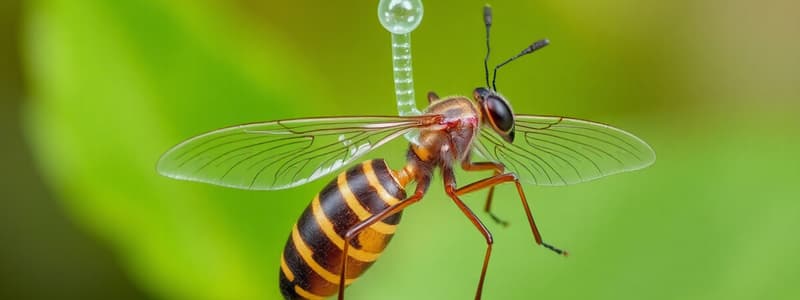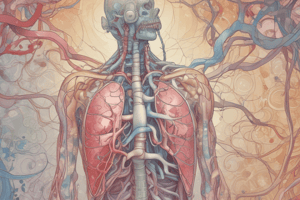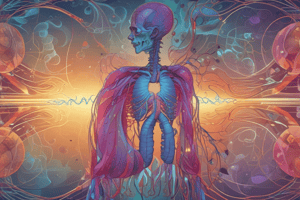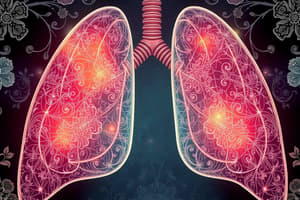Podcast
Questions and Answers
What is the primary role of goblet cells in the trachea?
What is the primary role of goblet cells in the trachea?
- Providing structural support
- Trapping dust and microbes (correct)
- Secreting surfactant
- Facilitating gas exchange
The trachea has a diameter of 1.2 cm.
The trachea has a diameter of 1.2 cm.
False (B)
What is the function of the smooth muscle in the trachea?
What is the function of the smooth muscle in the trachea?
To change the diameter of the trachea.
The wall of the alveolus is made of __________ epithelium.
The wall of the alveolus is made of __________ epithelium.
Match the following structures with their primary function:
Match the following structures with their primary function:
What is the diameter of a bronchiole?
What is the diameter of a bronchiole?
Alveoli contain goblet cells.
Alveoli contain goblet cells.
What is the purpose of surfactant in the alveoli?
What is the purpose of surfactant in the alveoli?
What adaptation do insects have to prevent water loss during gas exchange?
What adaptation do insects have to prevent water loss during gas exchange?
Mammals have a more efficient gas exchange system than insects.
Mammals have a more efficient gas exchange system than insects.
What is the function of the spiracles in insects?
What is the function of the spiracles in insects?
The _______ is the structure that divides the trachea into two bronchi in the human gas exchange system.
The _______ is the structure that divides the trachea into two bronchi in the human gas exchange system.
Match the following components of the human gas exchange system with their roles:
Match the following components of the human gas exchange system with their roles:
How do insects transport oxygen to their cells?
How do insects transport oxygen to their cells?
The lungs are located in the abdominal cavity in humans.
The lungs are located in the abdominal cavity in humans.
What primarily causes chronic bronchitis?
What primarily causes chronic bronchitis?
What is the primary purpose of the gas exchange system in insects?
What is the primary purpose of the gas exchange system in insects?
Exposure to airborne infections does not lead to allergic reactions in some individuals.
Exposure to airborne infections does not lead to allergic reactions in some individuals.
What is the major effect of smoking on the immune system?
What is the major effect of smoking on the immune system?
With chronic bronchitis, excess mucus can lead to the narrowing of the ______.
With chronic bronchitis, excess mucus can lead to the narrowing of the ______.
How does emphysema affect the lungs?
How does emphysema affect the lungs?
The rupture of alveoli can lead to increased surface area for gas exchange.
The rupture of alveoli can lead to increased surface area for gas exchange.
What role do macrophages play in lung infection response?
What role do macrophages play in lung infection response?
Match the respiratory conditions with their characteristics:
Match the respiratory conditions with their characteristics:
What is the primary health risk associated with benzene exposure?
What is the primary health risk associated with benzene exposure?
Sulfur dioxide has no long-term health effects.
Sulfur dioxide has no long-term health effects.
What are xerophytes adapted to do?
What are xerophytes adapted to do?
Soot is the result of _____ combustion of hydrocarbons.
Soot is the result of _____ combustion of hydrocarbons.
Match the following health effects with their corresponding pollutants:
Match the following health effects with their corresponding pollutants:
Which of the following characteristics is NOT a feature of xerophytes?
Which of the following characteristics is NOT a feature of xerophytes?
Cacti open their stomata during the day.
Cacti open their stomata during the day.
Plants rely on a large surface area for _____ and gas exchange.
Plants rely on a large surface area for _____ and gas exchange.
What role does surfactant play in the alveoli?
What role does surfactant play in the alveoli?
Alveoli are responsible for gas exchange through processes driven by changes in blood flow.
Alveoli are responsible for gas exchange through processes driven by changes in blood flow.
What is the main reason that oxygen diffuses from the alveoli into the blood?
What is the main reason that oxygen diffuses from the alveoli into the blood?
The distance across which gas exchange occurs is approximately __ micrometers.
The distance across which gas exchange occurs is approximately __ micrometers.
Match the following terms with their descriptions:
Match the following terms with their descriptions:
Which of the following conditions is included in chronic obstructive pulmonary disease (COPD)?
Which of the following conditions is included in chronic obstructive pulmonary disease (COPD)?
Elastic fibers in the walls of the alveoli prevent rupture during inhalation.
Elastic fibers in the walls of the alveoli prevent rupture during inhalation.
What harmful substance in tobacco smoke is known to affect the gas exchange system?
What harmful substance in tobacco smoke is known to affect the gas exchange system?
What is the typical volume of air someone with emphysema can force out after a deep breath?
What is the typical volume of air someone with emphysema can force out after a deep breath?
Recovery from COPD is possible in elderly patients.
Recovery from COPD is possible in elderly patients.
What is the primary cause of mutations in cells that lead to lung cancer?
What is the primary cause of mutations in cells that lead to lung cancer?
Carbon monoxide is a _____ gas that can lead to suffocation by binding to hemoglobin.
Carbon monoxide is a _____ gas that can lead to suffocation by binding to hemoglobin.
Which of the following is not a symptom of lung cancer?
Which of the following is not a symptom of lung cancer?
Match the following gases to their properties:
Match the following gases to their properties:
What diagnostic methods are used to confirm lung cancer?
What diagnostic methods are used to confirm lung cancer?
Lung cancer symptoms commonly appear during the early stages of tumor growth.
Lung cancer symptoms commonly appear during the early stages of tumor growth.
Flashcards
Gas Exchange
Gas Exchange
The process of exchanging gases like oxygen and carbon dioxide between an organism and its environment.
Surface Area to Volume Ratio in Gas Exchange
Surface Area to Volume Ratio in Gas Exchange
Large organisms often have a smaller surface area relative to their volume, making it difficult for them to efficiently exchange gases.
Internal Gas Exchange Systems
Internal Gas Exchange Systems
Internal gas exchange systems, like those found in insects and mammals, provide a larger surface area for gas exchange, improving efficiency.
Insect Exoskeletons
Insect Exoskeletons
Signup and view all the flashcards
Tracheae
Tracheae
Signup and view all the flashcards
Spiracles
Spiracles
Signup and view all the flashcards
Human Respiratory System
Human Respiratory System
Signup and view all the flashcards
Alveoli
Alveoli
Signup and view all the flashcards
Trachea Mucosa
Trachea Mucosa
Signup and view all the flashcards
Trachea Submucosa
Trachea Submucosa
Signup and view all the flashcards
Trachea Cartilage
Trachea Cartilage
Signup and view all the flashcards
Trachea Smooth Muscle
Trachea Smooth Muscle
Signup and view all the flashcards
Bronchus Structure
Bronchus Structure
Signup and view all the flashcards
Bronchiole Structure
Bronchiole Structure
Signup and view all the flashcards
Alveoli Function
Alveoli Function
Signup and view all the flashcards
Surfactant
Surfactant
Signup and view all the flashcards
What is surfactant?
What is surfactant?
Signup and view all the flashcards
What are alveoli?
What are alveoli?
Signup and view all the flashcards
What is concentration gradient?
What is concentration gradient?
Signup and view all the flashcards
How does oxygen move from the lungs into the blood?
How does oxygen move from the lungs into the blood?
Signup and view all the flashcards
How does carbon dioxide move from the blood into the lungs?
How does carbon dioxide move from the blood into the lungs?
Signup and view all the flashcards
How does tobacco smoke affect the gas exchange system?
How does tobacco smoke affect the gas exchange system?
Signup and view all the flashcards
What is COPD?
What is COPD?
Signup and view all the flashcards
How do small particles from tobacco smoke affect the lungs?
How do small particles from tobacco smoke affect the lungs?
Signup and view all the flashcards
Cilia
Cilia
Signup and view all the flashcards
Goblet Cells
Goblet Cells
Signup and view all the flashcards
Chronic Bronchitis
Chronic Bronchitis
Signup and view all the flashcards
Elastase
Elastase
Signup and view all the flashcards
Emphysema
Emphysema
Signup and view all the flashcards
Coughing
Coughing
Signup and view all the flashcards
What is the effect of decreased elastic recoil in the lungs?
What is the effect of decreased elastic recoil in the lungs?
Signup and view all the flashcards
What happens to the blood vessels and heart in advanced COPD?
What happens to the blood vessels and heart in advanced COPD?
Signup and view all the flashcards
What is lung cancer and where does it often develop?
What is lung cancer and where does it often develop?
Signup and view all the flashcards
What is metastasis?
What is metastasis?
Signup and view all the flashcards
What is carbon monoxide and how does it affect the body?
What is carbon monoxide and how does it affect the body?
Signup and view all the flashcards
What are the initial symptoms of carbon monoxide poisoning?
What are the initial symptoms of carbon monoxide poisoning?
Signup and view all the flashcards
How is exhaust gas released from a vehicle?
How is exhaust gas released from a vehicle?
Signup and view all the flashcards
What are some of the harmful chemicals found in vehicle exhaust?
What are some of the harmful chemicals found in vehicle exhaust?
Signup and view all the flashcards
Benzene's Impact on Health
Benzene's Impact on Health
Signup and view all the flashcards
The Effects of Sulfur Dioxide
The Effects of Sulfur Dioxide
Signup and view all the flashcards
The Dangers of Soot
The Dangers of Soot
Signup and view all the flashcards
Xerophytes: Plants in Dry Environments
Xerophytes: Plants in Dry Environments
Signup and view all the flashcards
Xerophyte Adaptations: Surface Area and Cuticle
Xerophyte Adaptations: Surface Area and Cuticle
Signup and view all the flashcards
Xerophyte Adaptations: Rolled Leaves
Xerophyte Adaptations: Rolled Leaves
Signup and view all the flashcards
Xerophyte Adaptations: Hairs Around Stomata
Xerophyte Adaptations: Hairs Around Stomata
Signup and view all the flashcards
Cacti Adaptations: Water Storage and Stomata
Cacti Adaptations: Water Storage and Stomata
Signup and view all the flashcards
Study Notes
Gas Exchange in Insects
- Insects have a network of tracheae, branching into tracheoles.
- Tracheoles extend to all parts of the body, even muscle fibers.
- Oxygen moves down tracheoles directly to cells.
- This gas phase exchange system is adapted to terrestrial life, minimizing water loss.
- Spiracles, valves on the insect's body, close to reduce water loss during rest.
Gas Exchange in Humans
- The human respiratory system links the circulatory and atmospheric systems.
- It includes nose, pharynx, larynx, trachea, bronchi, bronchioles, and alveoli.
- Bronchi branch into smaller bronchioles that lead to alveoli.
- Alveoli are in the lungs, with thin walls, maximizing gas exchange area.
- Pleural membranes surround the lungs, creating a space for smooth movement.
Human Respiratory System Mucosa
- The inner layer of the trachea is the mucosa.
- It's made of pseudostratified columnar ciliated epithelium and goblet cells.
- Goblet cells secrete mucus, which traps dust and microbes.
- Cilia sweep mucus out of the trachea, preventing lung entry.
- Submucosa is a connective tissue layer with glands and blood capillaries.
Structure and Function of the Trachea and Bronchi
- The trachea is supported by C-shaped cartilage rings to maintain shape and prevent collapse.
- Smooth muscle in the trachea adjusts diameter for air flow.
- Bronchi are similar to the trachea but smaller in diameter, also with cartilage.
Structure and Function of Bronchioles
- Bronchioles are the smallest airways.
- They lack cartilage and goblet cells.
- They have smooth muscle, controlling their diameter to regulate air flow.
- Respiratory bronchioles are even smaller, leading to alveoli.
Structure and Function of Alveoli
- Alveoli are the gas exchange surface in the lungs.
- They have a large surface area (about 700 million alveoli in lungs), maximizing gas exchange.
- Alveoli have thin walls (one cell thick) made of squamous epithelium, decreasing gas diffusion distance.
- They are moist to prevent cell dryness, and contain surfactant which lowers surface tension.
- Alveoli are surrounded by a network of capillaries for rapid gas exchange.
- Efficient ventilation maintains a high O2 and low CO2 concentration in the alveoli.
- Elastic tissues in alveoli expand and retract with breathing.
Gas Exchange Between Alveoli and Blood
- Oxygen diffuses from high concentration (air in alveoli) to low concentration (blood in capillaries).
- Oxygen dissolves in moisture in alveoli; then into blood cells' hemoglobin, and diffuses through cell membrane.
- Carbon dioxide follows the opposite concentration gradient, diffusing from blood to alveoli.
Harmful Substances in Tobacco Smoke
- Tobacco smoke contains harmful substances like tar (containing carcinogens).
- Tar settles in airways and stimulates lung damage.
- This can lead to chronic obstructive pulmonary disease (COPD), including chronic bronchitis and emphysema.
Chronic Bronchitis
- Tar destroys cilia, causing mucus build-up in airways.
- Leads to chronic cough and difficulty breathing.
- Swelling results as the airways further narrow.
- Bacteria and viruses become trapped.
Emphysema
- Loss of elastic fibers in alveoli, reducing their ability to recoil, trapping air inside
- Rupture of alveoli walls reduces surface area for gas exchange and gas diffusion.
- Leading to reduced oxygen intake.
Lung Cancer
- Most common cause is exposure to carcinogens, primarily from smoking.
- Cells divide uncontrollably, potentially leading to the spread to other organs through blood or lymph.
Smoking and Lung Cancer
- Strong correlation between smoking and lung cancer risk.
- Higher cigarette consumption leads to an amplified increase in lung cancer risk.
Harmful Components of Vehicle Exhaust
- Vehicle exhaust produces pollutants like carbon monoxide, sulfur dioxide, nitrogen oxides, etc.
- These pollutants damage the respiratory system in mammals with effects similar to smoking.
Gas Exchange in Plants
- Plants have waxy cuticles, stomata, and air spaces within leaves to maximize gas exchange, reducing loss during transpiration.
- Xerophytes have adaptations for living in dry environments, like thicker cuticles and smaller leaves.
- Hydrophytes (water plants) are adapted with broad leaves, allowing light capture and many air spaces for support.
Studying That Suits You
Use AI to generate personalized quizzes and flashcards to suit your learning preferences.




